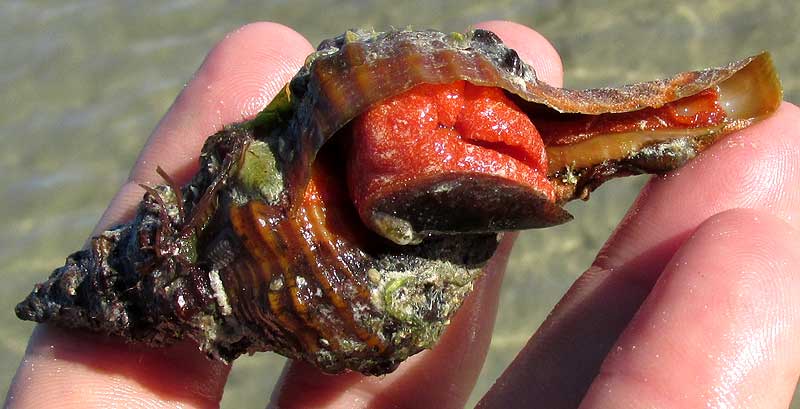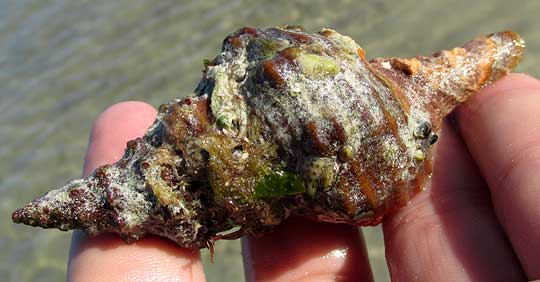Excerpts from Jim Conrad's
Naturalist Newsletter

from the March 1, 2015 Newsletter issued from Río Lagartos, on the Yucatan Peninsula's northern coast (~N21.60°, ~W88.16°), Yucatán state, MÉXICO
HORSE CONCH
Below you can see a seashell left on the beach's sand during a very low tide.

This was more than a seashell, though, because the living creature was still housed inside it. At the top of this page you can see its reddish-orange flesh starting to peep out.
I hoped to photograph the entire body extended from the shell but this was one of those times when the biting gnats, called chaquistas here, were so bad that it was foolhardy to stay still very long, and staying still was what was needed.
Volunteer identifier Bea in wintry Ontario easily identified this mollusk with its distinctively long, narrow front end, technically known as a siphonal canal, and orangish flesh. Mollusks with such pronounced canals can bury most of their bodies in mud or sand with the canal protruding, taking in water, or sometimes air, with it.
This is the Horse Conch, TRIPLOFUSUS GIGANTEUS. In certain field guides it's labeled the Florida Horse Conch, but that won't do, because the species is distributed from North Carolina in the US south through the Gulf of Mexico and Caribbean, to here in the Yucatan.
The species name "giganteus" means what it seems to, and I wondered about that because our individual's shell was a little less than four inches long (10cm). However, it's true: The species reaches about two feet long (60cm), so ours in a young one. Such small ones are what I find here, though. I suspect that larger ones are quickly harvested by those numerous folks who at low tide wander the beaches and mud flats collecting "conchas" to eat and sell. The Horse Conch is recognized by many as the world's second-largest living gastropod, gastropods being snail-like creatures. In American waters, the Horse Conch is the largest gastropod of all.
Horse Conches live on sand and mud flats from the low intertidal to shallow subtidal zones, to as deep as 20 feet (6 m). The species is carnivorous, feeding on other large marine gastropods, possibly including members of its own species. In aquaria it's been seen eating small hermit crabs.
Large Horse Conch shells were often used by ancient native Americans as drinking vessels, woodworking tools and hammers. In classic Mayan art, Horse Conch shells can be seen used as paint and ink holders for scribes, and as bugles and trumpets.